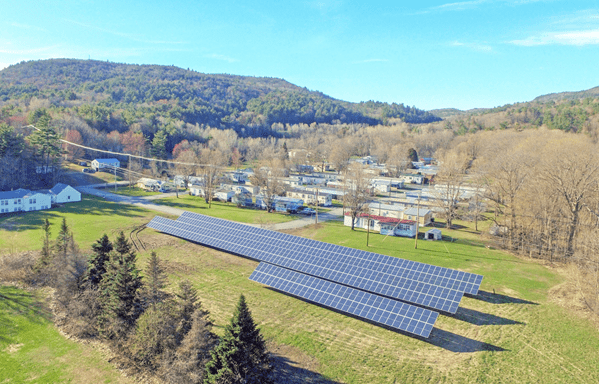Solar for Manufactured Homes: The Next Frontier for Energy Equity

Mascoma Meadows Community Solar Array. Photo Credit: ReVision Energy
There is a growing movement in the clean energy field to bring the benefits of renewable energy to low- and moderate-income communities. A new report by the Clean Energy States Alliance explores the opportunities and challenges of bringing solar to an often-overlooked market that is ripe with potential: manufactured homes.
Manufactured homes, formerly referred to as mobile homes, account for 6.1% of the nation’s housing stock, totaling more than 8,500,000 residences. In some states, the percentage of households in manufactured homes reaches as high as 17%t. Median income in these households is typically half that of people in other housing types. Most manufactured homes are situated in rural areas.
Unlike the broader low- and moderate-income population, most manufactured housing residents are homeowners. This means that they are likely to live in their property longer than renters, they can make physical changes to their property, and they can build home equity through improvements to their property, all good indicators of solar readiness.
Most manufactured homes are located near other manufactured homes. This creates an opportunity for targeted outreach campaigns because the homes are clustered together. It also means that “solar contagiousness” could play a big role in spreading solar in these communities: a recent study by Scientific Reports found that the single greatest predictor of going solar is proximity to other homes with solar, and that this is especially pronounced in lower income areas.
The main benefit for manufactured housing residents in going solar is cost savings. Low-income populations often suffer from a high energy burden, meaning that a larger share of their household income goes towards energy expenses; lessening a household’s energy burden would free up much needed funds for other important expenses. Manufactured homes are generally energy inefficient and have high electric loads, so with the right policies and incentives, the potential for cost savings from solar could be significant.
There are several challenges to solar adoption for manufactured housing residents. Some of these challenges are the same as those that other low-income households face:
- High upfront costs of solar
- Inability to take financial risks
- Difficulty in taking advantage of federal tax credits due to low tax burden
- Being ignored by solar marketers
- Audience is unfamiliar with solar
Other challenges are specific to the manufactured housing market:
- Roofs may not be able to support solar panels
- Limited space for ground-mounted solar
- Homeowners in manufactured home communities typically do not own the land they reside on
- While most homes remain in one location, they are technically mobile units, and there can be hesitancy to add due to potentially needing to move the home in the future
Despite these challenges, there are some successful examples of manufactured housing communities going solar.
The Mascoma Meadows Cooperative Community Solar Array in Lebanon, New Hampshire is a 100-kW solar PV system benefitting 45 households. Mascoma Meadows residents own their own individual homes and share ownership of the land they live on through a cooperative ownership framework. The community solar array is built on a half-acre of land donated by a neighboring church. The solar array is anticipated to save each of the participating households $20-25 in housing lot rent reduction per month.
In New Mexico, a state with a high poverty rate and the highest percentage of manufactured housing residents, the PV on a Pole TM initiative addresses several barriers to going solar. With four solar panels mounted atop a vertical pole, solar is achievable for manufactured housing residents with roofs that cannot support solar panels. The small footprint works well for those who do not have enough land to support a ground-mounted installation. The streamlined setup means that the solar panels can be installed quickly and affordably, and that they can be moved and re-installed without too much additional cost or effort.
Based on an in-depth analysis of the solar and manufactured housing landscape across the country, the Clean Energy States Alliance recommends eight strategies for advancing solar in manufactured homes:
- Assess the manufactured housing stock in the state or utility service territory.
- Start with modest targeted efforts and produce a track record of success by focusing on low-hanging fruit.
- Recognize that special funding or incentives will be necessary and ensure that financial benefits are flowing to the residents.
- Find the best venues for pursuing a “solarize” strategy (a community-based education/marketing campaign with group discount pricing). This can address residents’ limited familiarity with solar and is well matched to manufactured home communities and informal subdivisions.
- Target resident-owned communities (in which land is owned by the residents) and other nonprofit communities (e.g., community land trusts, housing agencies). This makes it easier to ensure that savings flow to residents.
- Promote certain types of large community-scale solar arrays. Some projects can power community facilities and common loads. Others can help meet state community solar mandates.
- Support efforts to incorporate solar into new manufactured homes. As with other housing types, this is the simplest route to incorporating solar in terms of financing and manufacturing, but there is an important limitation to keep in mind: most manufactured housing residents live in older units, especially those who are most in need of electricity cost savings.
- Consider third-party ownership, on-bill financing, and other special financing options.
“This is a large market, it’s an important market,” said CESA Executive Director and report lead author Warren Leon in a solar for manufactured homes webinar on May 13. “If we care about solar being a technology that benefits all of society, we cannot ignore this market.”
This article was originally published in PV Magazine.
Published On
June 21, 2021

